The Original Duck Boat
Explore the fascinating story of the original duck boat. Learn about the history and evolution of duck hunting boats and their significance in waterfowl hunting.
Explore the fascinating story of the original duck boat. Learn about the history and evolution of duck hunting boats and their significance in waterfowl hunting.
When early hunters headed to the marshes in pursuit of ducks and geese, they did so in handmade canoes. In many of today's waterfowling scenarios, the original duck boat can still be your best option for getting you and your gear where you need to go.
They drifted in just as we hoped they wouldsporadic flocks of mallards hovering over the decoys. Thirsty and fresh from field feeding, they had been coming to the lake all morning, avoiding the shorelines where hunters might lurk and instead heading for the safety of a small island.
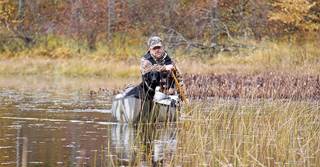
Photo MICHAELFURTMAN.COM
Except the island wasn't so safe that day. My buddy Shannon and I were both concealed there in well-grassed layout blinds tucked into the sparse vegetation. Bella, my black Lab, wore a ghillie suit of sorts and sat behind my blind, wet and happy from several earlier retrieves. We took two more greenheads and reached our mallard limits, and then we waited for a pintail or wigeon to round out our bag.
Patience is a virtue, they say, and patience paid off. When we heard the whistles of pintail drakes, we froze in our blinds, moving nothing but our eyes. They came from behind, passed overhead, then were going away when we grabbed our pintail whistles and called. The flock responded. Like the mallards, they parachuted from the clear sky, dropping toward the bright water and our decoys. We both picked drakes, and when they hit the water, Bella did her thing. We were done. It felt good to stand up.
"We were on the X today, Mike," Shannon said. "Damn fine hunt."
Fine indeed. But you can't be on the X if you can't get to the X, and we were the only hunters who could do so that morning for one simple reason: We had a canoe.
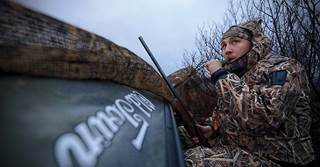
Photo Old Town
The prairie lake where we were hunting had no boat launch. And even if you could have launched a boat, much of the lake was too shallow for an outboard. A mud motor might work, but with only sparse vegetation along the shores, even the best-brushed johnboat would be hard to hide.
Don't get me wrong. I love all kinds of duck boats, big and small, motorized and human-powered. But if someone told me that I could have only one watercraft from which to hunt ducks, I'd have to choose a canoe. Your needs could well be different, but for hunting the lakes and rivers of the upper Midwest and the sloughs and shallow lakes of the prairies, a canoe is often the ideal choice.
A canoe painted camo or olive drab is just another log when overturned on a beach, making it a cinch to hide. Drafting only a couple of inches, it is ideal for shallow water. And because a canoe is light enough for one or two hunters to carry, those ducky looking spots with no boat launch become huntable. You can silently sneak up on ducks for jump-shooting or travel across a lake to your destination without busting out every duck in hearing range. And its very shape makes paddling, poling, or pulling it through reeds or cattails much easier than any other boat.
My first duck hunt was in my father's square-stern Old Town canoe. The first duck boat I owned was an Old Town Pathfinder canoe. All around the globe, the first watercraft that many cultures developed was the canoe. Some were carved from logs, and others were made from bark or animal skin. I have little doubt that when these early people hunted waterfowl, some kind of canoe was put to work. Thus, it's likely that the canoe was the original duck boat.
And it's still a good one.

Photo BILLBUCKLEYPHOTO.COM
The young college guys had picked a good spot on one of the better duck lakes near my home. It was a relatively short paddle to the island where they had set decoys in the lee. They enjoyed a good shoot. Then things went wrong.
They didn't have a retriever, so they paddled their canoe out to fetch their ducks. That worked great when both of them went, but late in the hunt one of the young men set out by himself. He sat in the stern and, with all the weight in the back of the boat, the bow rose high above water, acting as a sail and effectively shortening the length of the canoe. When the young hunter reached over the side to grab the duck, he was flipped into the frigid lake. Then a gust of wind quickly separated him from the boat. Not only was he in trouble, his partner was now stranded.
Wisely, the hunter in the water was wearing a life jacket, and he began to swim toward the island. His partner was already on the phone to 911. But even before the swimming hunter had reached shore, or the authorities had responded, another group of hunters returning from their shoot in a boat saw the drifting canoe and figured out that someone was in trouble. They found the young man, pulled him from the water, and ran him to the boat launch, where he could warm in their truck. Then they returned for the other hunter and brought him to shore.
These young guys were lucky. But if there had been no other hunters nearby, and cell service had been unavailable, it could have been tragic.
Stories like this scare people away from using a canoe. Are canoes tippier than johnboats? Sure. Are they dangerous? No. But they do require a bit more practice and skill than most boats. In this instance, if the lone hunter had simply knelt near the center of the canoe, or if he had turned the craft around and sat reversed in the bow seat, the canoe would never have tipped.
My dad taught me that. And other things.
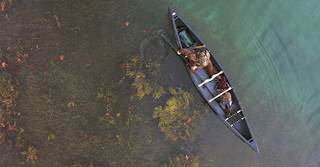
Photo Old Town
After lowering my brother's Grumman canoe from his shoulders, Dad set it in the water, parallel to shore. Normally we used Dad's square-stern canoe, but the lake we chose to hunt was too far from a road to carry that heavy boat, and an outboard would be useless in the thick wild rice. So we borrowed the 17-foot Grumman instead. I swung a big sack of decoys from my shoulders and set it upright in the middle of the canoe. Dad gave me a severe glance.
"Always, always, always," he said, "keep the center of balance low in a canoe. Either lay that sack down or, better yet, empty the decoys from it so they can be spread out."
That is a lesson too few ever learn. The higher your center of gravity, the tippier the canoe will be. As much of your gear should be below the gunwales as possible. Decoys, shell boxes, shotguns, and other heavy items should be near the bottom, with lighter gear on top. But even lightweight items shouldn't rise too much above the gunwalesnot because they increase the risk of tipping that much, but because they can catch the wind. Paddlers should also "make themselves small" by crossing their ankles, feet under the seat, knees angled out and down. When the water gets rough, it's a good idea to simply sink to your knees until you're in the clear.
With the canoe properly loaded, Dad told me to get in. He stood calf deep in the water, holding the canoe steady while I climbed over the side and into the bow seat. I then braced the canoe with my paddle as he got into the stern. Finally, Dad told Kim, our black Lab, to kennel up, and she sat in front of him.
Canoes should be entered and exited from the side and only when they are fully afloat, because if the bow or stern is up on the shore, the craft will be balanced at the roundest part of the hull. That makes the risk of tipping greater. This is especially true when coming into shore. If you paddle the canoe straight up onto shore and the bow paddler climbs out, all the weight will be in the rear, and the likelihood of flipping the canoe will be greater. And the dog? The dog gets in last and gets out first, only on command and only when both paddlers are ready.
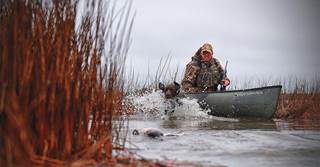
Photo Old Town
It was getting near shooting time when we finally reached the spot where Dad wanted to set up. He steered the canoe toward a thick stand of cattails along the bank. I never questioned Dad's duck hunting wisdom, but I did wonder how hunting from the canoe would work. His wide, flat, square stern was stable enough to stand up in and shoot, but I had my doubts about my brother's canoe.
Dad poled us into a spot in the cattails where we were overlooking the dekes. Telling Kim to stay, and telling me to brace, he moved to the center of the canoe, grabbed a stout bundle of cattails from the inshore side, and bent them over the center yoke. He put a quick half hitch of strong cord around them, then grabbed a bundle of cattails from the other side, bent them down over the others, and wound the remaining cord around the bundles and the canoe's yoke.
Then he wiggled the canoe with his feet. "Pretty solid, Mike. You'll be able to stand to shoot. Just wait for me to call it, though, so we're both ready. And if we need to help Kim retrieve a duck, it's as simple as pulling the half hitch out of the cord and poling out." Knowing Kim, I figured she wouldn't need our help. And I was right.
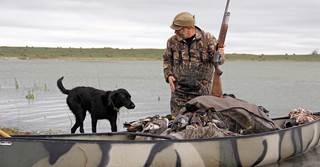
Photo MICHAELFURTMAN.COM
Canvasbacks like big, open waterwater that's bigger than most think a canoe can handle. But the forecast for the day Shannon and I went out was for light winds in the morning, not rising to anything treacherous until afternoon. The forecast was only half right.
We had chosen to hunt a prairie lake where we had seen rafts of canvasbacks the day before. Again, there was no boat launch. Access to the water was from the side of a public road. The plan was to paddle the three-quarters of a mile to where we'd hunt, bag our birds, and be long gone before the wind picked up.
We did bag our birdstwo cans eachand rounded out our limits with redheads and wigeon. But the wind rose hard and early. By the time we had picked up the decoys and loaded the canoe, there were frothing whitecaps atop two-foot seas. We were thankful that we'd be running with the wind on our way back to the truck.
My canoe is 17 feet long and 13 inches deep. That depth is important in rough water, lest the waves slop over the side as they roll down the canoe's length. We had at least two inches to spare, despite the load we were carrying. I was at ease, but not foolish, as we raced down the lake, thanks to a lifetime of paddling big water. Shannon, a native Texan, had as many years of experience in pirogues, which are essentially canoes. It helps to have trust in your paddling partner.
I know I was grinning as we surfed down the lake. We had taken a fine bag of ducks from a glorious spot that other hunters couldn't reach, and every duck circling the lake had been ours alone to work. The canoe made all that possible, and now it was taking us safely back. As we approached the shore, we noticed a familiar pickup on the road. Homer and his son Wyatt, two of Shannon's Texas friends, were on their first trip to the prairies. Knowing our plans, and concerned about the wind, they had driven out to make sure we were OK.
Wyatt waded out to help steady the canoe as we disembarked. Then all of us gave it a good tug ashore. "We figured we'd be retrieving your sorry butts from the water," Homer said, only half in jest. "You guys must be crazy."
"Oh hell, Homer," I said, "riding the waves was fun! The canoe didn't take on a drop of water. And look at the nice string of ducks we shot!
Crazy? Crazy about ducks, sure. But not crazy for choosing a canoe.
Ducks Unlimited uses cookies to enhance your browsing experience, optimize site functionality, analyze traffic, and deliver personalized advertising through third parties. By continuing to use this site, you agree to our use of cookies. View Privacy Policy